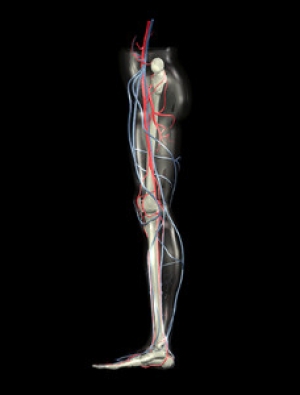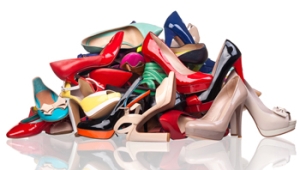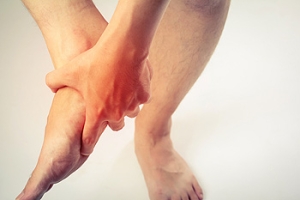
Gout
Gout is a form of arthritis that is caused by a buildup of uric acid crystals in the joints. This considered to be one of the most frequently recorded medical illnesses throughout history. Gout occurrences in the US have risen within the past twenty years and the condition now affects 8.3 million people which is 4% of all Americans. Researchers have found that gout affects men more than women and African-American men more than white men.
Symptoms of gout are warmth, swelling, discoloration, and tenderness in the affected joint area. The small joint on the big toe is the most common place for a gout attack to occur.
People who are obese, gain weight excessively, drink alcohol heavily, have high blood pressure, or have abnormal kidney function are more likely to develop gout. Furthermore, certain drugs and diseases are likely to increase levels of uric acid in the joints which eventually leads to gout. You are also more likely to develop gout if you eat a lot of meat and fish.
Many who experience gout attacks will experience repeated attacks over the years. Some people who have gout symptoms, may never have them again, but others may experience them several times a year. If you have gout symptoms throughout the year, you may have recurrent gout. Those who have gout should also be careful about their urate crystals collecting in their urinary tract, because this may lead to kidney stones.
Diagnosis for gout is done by checking the level of uric acid in the joints and blood. Your podiatrist may also prescribe medicine to reduce uric acid buildup in the blood, which will help prevent any gout attacks.
To treat gout, your podiatrist may also prescribe you Anti-inflammatory medication (NSAIDs) which will relieve the pain and swelling of a gout episode and it can also shorten a gout attack. Maintaining a healthy diet is also a proven method to prevent gout attacks.
Symptoms and Causes of Poor Circulation
Poor circulation occurs when blood flow to a specific part of your body is reduced. 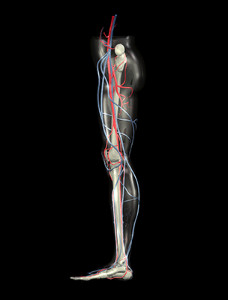 Several conditions such as heart disease, diabetes, and obesity, can all lead to poor circulation. Unhealthy behaviors can be attributing factors, including smoking cigarettes, lack of exercise, and having high cholesterol. Poor circulation in the feet can be caused by peripheral artery disease, or PAD. PAD is the result of a buildup of plaque in the arteries. Poor circulation is also known to cause muscle pain, stiffness, skin discoloration, and erectile dysfunction. People who have diabetes and smoke are at the greatest risk for poor blood circulation, as well as those who are over the age of 50. Exercising and maintaining a healthy lifestyle can drastically improve conditions. If you are experiencing complications from poor circulation in your lower extremities, it is advised that you consult with a podiatrist.
Several conditions such as heart disease, diabetes, and obesity, can all lead to poor circulation. Unhealthy behaviors can be attributing factors, including smoking cigarettes, lack of exercise, and having high cholesterol. Poor circulation in the feet can be caused by peripheral artery disease, or PAD. PAD is the result of a buildup of plaque in the arteries. Poor circulation is also known to cause muscle pain, stiffness, skin discoloration, and erectile dysfunction. People who have diabetes and smoke are at the greatest risk for poor blood circulation, as well as those who are over the age of 50. Exercising and maintaining a healthy lifestyle can drastically improve conditions. If you are experiencing complications from poor circulation in your lower extremities, it is advised that you consult with a podiatrist.
While poor circulation itself isn’t a condition; it is a symptom of another underlying health condition you may have. If you have any concerns with poor circulation in your feet contact Larry J. Kipp, DPM of Coastal Podiatry Center. Our doctor will treat your foot and ankle needs.
Poor Circulation in the Feet
Peripheral artery disease (PAD) can potentially lead to poor circulation in the lower extremities. PAD is a condition that causes the blood vessels and arteries to narrow. In a linked condition called atherosclerosis, the arteries stiffen up due to a buildup of plaque in the arteries and blood vessels. These two conditions can cause a decrease in the amount of blood that flows to your extremities, therefore resulting in pain.
Symptoms
Some of the most common symptoms of poor circulation are:
- Numbness
- Tingling
- Throbbing or stinging pain in limbs
- Pain
- Muscle Cramps
Treatment for poor circulation often depends on the underlying condition that causes it. Methods for treatment may include insulin for diabetes, special exercise programs, surgery for varicose veins, or compression socks for swollen legs.
As always, see a podiatrist as he or she will assist in finding a regimen that suits you. A podiatrist can also prescribe you any needed medication.
If you have any questions, please feel free to contact our office located in New Port Richey, FL . We offer the newest diagnostic and treatment technologies for all your foot care needs.
Causes Symptoms and Treatment for Poor Circulation in the Feet
The purpose of the body’s circulation system is to transport blood, oxygen, and nutrients throughout the body. A reduction of blood to a specific part of the body may cause one to experience symptoms of poor circulation. The most common causes of poor circulation in the feet are obesity, diabetes, and heart conditions such as peripheral artery disease (PAD). Common symptoms of poor circulation include tingling, numbness, throbbing, pain and muscle cramps.
Peripheral artery disease is a common cause of poor circulation in the legs. Symptoms of PAD are cramping, pain or tiredness in the leg or hip muscles while walking or climbing stairs. This pain tends to go away with rest and starts back up when you begin to walk. It is a condition that causes the blood vessels and arteries to become narrow. Although PAD is more common in adults over the age of 50, it may also occur in younger people. A similar condition called atherosclerosis causes arteries to stiffen up due to a buildup of plaque in the arteries and blood vessels.
Blood clots are also a common cause of poor circulation in the feet. Clots may obstruct blood vessels and if they occur in the legs, they may eventually lead to pain and discoloration. This occurrence is commonly known as deep vein thrombosis (DVT) and it may travel to the lungs. Varicose veins are another condition that may lead to poor circulation, and it is caused by incompetence of the valves in the veins. Women who are overweight are prone to developing this condition. Lastly, diabetes, which is correlated with poor blood sugar metabolism may lead to chronic poor circulation. Those with diabetes often suffer from cramping in the legs, calves, thighs and buttocks.
If you are looking for ways to avoid poor circulation there are some tips you can follow. One tip is to avoid sitting for too long. If you plan to sit down for a long period of time, you should try standing up occasionally, to improve your circulation. Another great way to avoid poor circulation is to exercise. Exercise is an excellent way to pump the heart and increase blood flow. Those who suffer from poor circulation should also avoid smoking, reduce their salt intake, and try to lose weight.
If you are experiencing symptoms from poor circulation in your feet, you should consult with your podiatrist to determine the best method for treatment for you. He or she may prescribe medication in addition to recommending specific lifestyle changes to improve your circulation.
How to Choose High Heels
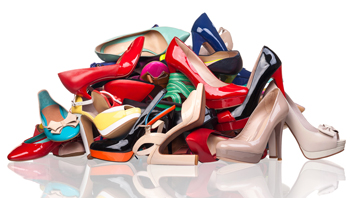 The benefits of wearing high heels can include the legs appearing longer and slimmer. It may come with a price of having foot pain, and this can be the result of the shoes having inadequate room for the toes to move freely in. If the desire is strong to wear high heels, there are a variety of methods that can be implemented which may diminish foot pain. These can include getting your feet properly measured to determine the correct shoe size, keeping the heels about two inches high, and making sure there is enough cushioning and support in the shoe. Additionally, it may be beneficial to choose shoes that have rounded toes, as this can be helpful in preventing bunions, and other foot conditions. If you would like additional information on how high heels can affect your feet, please consult with a podiatrist.
The benefits of wearing high heels can include the legs appearing longer and slimmer. It may come with a price of having foot pain, and this can be the result of the shoes having inadequate room for the toes to move freely in. If the desire is strong to wear high heels, there are a variety of methods that can be implemented which may diminish foot pain. These can include getting your feet properly measured to determine the correct shoe size, keeping the heels about two inches high, and making sure there is enough cushioning and support in the shoe. Additionally, it may be beneficial to choose shoes that have rounded toes, as this can be helpful in preventing bunions, and other foot conditions. If you would like additional information on how high heels can affect your feet, please consult with a podiatrist.
High heels have a history of causing foot and ankle problems. If you have any concerns about your feet or ankles, contact Larry J. Kipp, DPM from Coastal Podiatry Center. Our doctor can provide the care you need to keep you pain-free and on your feet.
Effects of High Heels on the Feet
High heels are popular shoes among women because of their many styles and societal appeal. Despite this, high heels can still cause many health problems if worn too frequently.
Which Parts of My Body Will Be Affected by High Heels?
- Ankle Joints
- Achilles Tendon – May shorten and stiffen with prolonged wear
- Balls of the Feet
- Knees – Heels cause the knees to bend constantly, creating stress on them
- Back – They decrease the spine’s ability to absorb shock, which may lead to back pain. The vertebrae of the lower back may compress.
What Kinds of Foot Problems Can Develop from Wearing High Heels?
- Corns
- Calluses
- Hammertoe
- Bunions
- Morton’s Neuroma
- Plantar Fasciitis
How Can I Still Wear High Heels and Maintain Foot Health?
If you want to wear high heeled shoes, make sure that you are not wearing them every day, as this will help prevent long term physical problems. Try wearing thicker heels as opposed to stilettos to distribute weight more evenly across the feet. Always make sure you are wearing the proper shoes for the right occasion, such as sneakers for exercising. If you walk to work, try carrying your heels with you and changing into them once you arrive at work. Adding inserts to your heels can help cushion your feet and absorb shock. Full foot inserts or metatarsal pads are available.
If you have any questions please feel free to contact our office located in New Port Richey, FL . We offer the newest diagnostic and treatment technologies for all your foot and ankle needs.
Why High Heels Are Not Ideal for Healthy Feet
It is no secret that high heels are uncomfortable to wear for long periods of time. Although beauty is pain, you should not sacrifice the health of your feet for a stylish heel. Wearing high heels can potentially cause many different foot conditions that may be avoided by wearing proper footwear.
The structure of high heels forces weight of your body to get shifted forward toward the ball of the foot. The higher the heel you wear, the more weight and pressure get shifted forward. The pressure that your toes may experience from wearing heels may lead to hammer toes, bunions, and ingrown toenails. Extra weight and pressure resulting from wearing heels may cause stress fractures. Furthermore, heels may cause pinched nerves which may result in Morton’s neuroma.
High heels are even more dangerous for people who are clumsy. Falling or tripping while wearing heels can cause an ankle sprain or twist.
What many people don’t know is that heels can also cause back and knee problems. In order for your body to stay balanced on heels, your spine has to sway unnaturally, which adds stress to your spine muscles. This may cause you to experience a sore lower back.
If you decide to wear high heels regardless of the risks associated with them, there are ways you can minimize their harmful effects. One way to reduce injury is to massage and stretch your legs at the end of the day. Stretching can prevent the Achilles tendons and calf muscles from becoming too tight. If you are simply looking for more height, wedges and platforms provide a better surface area to distribute the body weight across compared to thinner heels.
If you experience pain from wearing high heels, it is important to see a podiatrist before any of your symptoms become worse.
What Causes Hammertoe?
 The medical condition that is known as hammertoe occurs when the second and third toes bend downward at the middle joint, causing them to resemble a hammer. This ailment can come from genetic factors, or from wearing shoes that do not have adequate room for the toes to move freely in. Additionally, there may be existing medical conditions which can lead to the development of hammertoes, which can include bunions, or different forms of arthritis. The symptoms that are associated with this condition often include pain in the foot as the toes are stretched downward, and there may be calluses and corns that form on the top of the bent joints. Mild relief may be found when the feet are soaked in warm water, which can make it easier for the toes to stretch by pointing and flexing the ankles. For severe cases of hammertoe, a splint is applied to the affected toes to help keep them as straight as possible. If you have developed this condition, it is strongly suggested that you consult with a podiatrist who can offer treatment options that are correct for you.
The medical condition that is known as hammertoe occurs when the second and third toes bend downward at the middle joint, causing them to resemble a hammer. This ailment can come from genetic factors, or from wearing shoes that do not have adequate room for the toes to move freely in. Additionally, there may be existing medical conditions which can lead to the development of hammertoes, which can include bunions, or different forms of arthritis. The symptoms that are associated with this condition often include pain in the foot as the toes are stretched downward, and there may be calluses and corns that form on the top of the bent joints. Mild relief may be found when the feet are soaked in warm water, which can make it easier for the toes to stretch by pointing and flexing the ankles. For severe cases of hammertoe, a splint is applied to the affected toes to help keep them as straight as possible. If you have developed this condition, it is strongly suggested that you consult with a podiatrist who can offer treatment options that are correct for you.
Hammertoes can be a painful condition to live with. For more information, contact Larry J. Kipp, DPM of Coastal Podiatry Center. Our doctor will answer any of your foot- and ankle-related questions.
Hammertoe
Hammertoe is a foot deformity that occurs due to an imbalance in the muscles, tendons, or ligaments that normally hold the toe straight. It can be caused by the type of shoes you wear, your foot structure, trauma, and certain disease processes.
Symptoms
- Painful and/or difficult toe movement
- Swelling
- Joint stiffness
- Calluses/Corns
- Physical deformity
Risk Factors
- Age – The risk of hammertoe increases with age
- Sex – Women are more likely to have hammertoe compared to men
- Toe Length – You are more likely to develop hammertoe if your second toe is longer than your big toe
- Certain Diseases – Arthritis and diabetes may make you more likely to develop hammertoe
Treatment
If you have hammertoe, you should change into a more comfortable shoe that provides enough room for your toes. Exercises such as picking up marbles may strengthen and stretch your toe muscles. Nevertheless, it is important to seek assistance from a podiatrist in order to determine the severity of your hammertoe and see which treatment option will work best for you.
If you have any questions, please feel free to contact our office located in New Port Richey, FL . We offer the newest diagnostic and treatment technologies for all your foot care needs.
Hammertoe
Hammertoe is a foot deformity that occurs due to an imbalance in the tendons, muscles, or ligaments that are responsible for holding the toes in their normal position. This condition may be caused by poor footwear, foot structure, trauma, and disease. The most common solution for hammertoe is to relieve the pain by changing your footwear and wearing orthotics. In severe cases, surgery may be required.
The shoes that are most likely to cause hammertoe are high heeled shoes or shoes that are too tight in the toe box. Tight shoes will force your toes to crowd together in a curled position. This position will likely continue when you take your shoes off. Another cause is trauma. When you stub your toe, you are increasing the chance that you will develop hammertoe.
There are risk factors that may make you more likely to develop this condition. Women are more likely to have the condition compared to men, and it is also more likely to appear in those who are older in age.
Many different foot problems can be avoided by wearing shoes that have adjustability, adequate toe room, and low heels. Furthermore, if you want to buy new shoes, you should look to purchase them at the end of the day and make sure you know your correct size. The importance of buying shoes at the end of the day is that your feet swell as the day progresses. You should also ensure that you are wearing your correct size because your shoe size may change as you grow older.
To diagnose someone with hammertoe, your podiatrist will need to conduct a thorough examination of your foot. Your doctor may even order an x-ray to evaluate the bones and joints of your feet and toes.
If you have hammertoe, your podiatrist may recommend that you wear shoes that fit you better along with inserts to place inside them. Additionally, he or she may suggest special exercises for you to perform to stretch your toes. One helpful exercise it to pick up marbles with your feet or crumple a towel with your toes.
Prior to meeting with your podiatrist, it will be helpful to make a list of all the symptoms you are experiencing. You should also make a note of medications you are taking and important personal information about your medical history.
Signs You May Have Toenail Fungus
 The symptoms of toenail fungus are fairly noticeable. An obvious sign that you may have developed this condition often includes a discoloration of the toenail. It will typically start with the big toenail, and will begin by turning a yellowish color. If it is not promptly treated, the nail may become brittle and crumble, and can gradually pull away from the toe. The fungus that causes this condition lives and thrives in warm and moist environments. These include public pools, locker rooms, and shower room floors. When appropriate shoes are worn, the chances of getting toenail fungus may be diminished. If you feel you have developed this condition, it is suggested to consult with a podiatrist who can properly diagnose and treat this condition.
The symptoms of toenail fungus are fairly noticeable. An obvious sign that you may have developed this condition often includes a discoloration of the toenail. It will typically start with the big toenail, and will begin by turning a yellowish color. If it is not promptly treated, the nail may become brittle and crumble, and can gradually pull away from the toe. The fungus that causes this condition lives and thrives in warm and moist environments. These include public pools, locker rooms, and shower room floors. When appropriate shoes are worn, the chances of getting toenail fungus may be diminished. If you feel you have developed this condition, it is suggested to consult with a podiatrist who can properly diagnose and treat this condition.
If left untreated, toenail fungus may spread to other toenails, skin, or even fingernails. If you suspect you have toenail fungus it is important to seek treatment right away. For more information about treatment, contact Larry J. Kipp, DPM of Coastal Podiatry Center. Our doctor can provide the care you need to keep you pain-free and on your feet.
Symptoms
- Warped or oddly shaped nails
- Yellowish nails
- Loose/separated nail
- Buildup of bits and pieces of nail fragments under the nail
- Brittle, broken, thickened nail
Treatment
If self-care strategies and over-the-counter medications does not help your fungus, your podiatrist may give you a prescription drug instead. Even if you find relief from your toenail fungus symptoms, you may experience a repeat infection in the future.
Prevention
In order to prevent getting toenail fungus in the future, you should always make sure to wash your feet with soap and water. After washing, it is important to dry your feet thoroughly especially in between the toes. When trimming your toenails, be sure to trim straight across instead of in a rounded shape. It is crucial not to cover up discolored nails with nail polish because that will prevent your nail from being able to “breathe”.
In some cases, surgical procedure may be needed to remove the toenail fungus. Consult with your podiatrist about the best treatment options for your case of toenail fungus.
If you have any questions, please feel free to contact our office located in New Port Richey, FL . We offer the newest diagnostic and treatment technologies for all your foot care needs.
Treating Toenail Fungus
Fungal infection of the toenail, or onychomycosis, typically appears as a gradual change in a toenail’s texture and color that involves brittleness and darkening. The fungal infection itself occurs beneath the surface of the nail. Aside from discoloration, other symptoms include the collection of debris beneath the nail plate, white marks on the nail plate, and a foul odor emanating from the nail. If ignored, the infection can spread into other nails and the skin; in severe cases, it can hinder one’s ability to work or walk.
The toenails are particularly vulnerable to contracting infection in moist environments where people are likely to be walking barefoot, such as around swimming pools, public showers, and locker rooms. Fungal infection may also be more likely to occur in nail beds that have been injured, and sufferers of chronic diseases such as diabetes, circulatory problems, or immunodeficiency conditions are particularly prone to developing fungal nails.
Fungal nails can be primarily prevented by practicing proper hygiene and regularly examining the feet and toes. Carefully washing the feet with soap and water and thoroughly drying the feet afterwards are essential. Other tips include wearing shower shoes in public areas, changing shoes and socks daily, keeping toenails clipped at a short length, wearing breathable shoes that fit properly, wearing moisture-wicking socks, and disinfecting home pedicure tools and instruments used to cut nails.
Fungal nail treatment may vary between patients and the severity of the condition. Your podiatrist may suggest a daily routine of cleansing that spans over a period of time to ease mild infections. Over-the-counter or prescription antifungal agents may also be prescribed, including topical and/or oral medications. Debridement, or the removal of diseased nail matter and debris, may also be performed. In more severe cases, surgical treatment may be needed. In some instances, the temporary removal of the fungal nail allows for the direct application of a topical antifungal to the nail bed. In other cases, a chronically painful fungal nail that has not responded to other treatments may be permanently removed; this allows the infection to be cured and avoids the growth of a deformed nail.
Different Types of Arthritis in the Feet
 The feet are comprised of numerous bones, joints, and tendons. Patients who are afflicted with arthritis in the feet may notice changes that occur in the arch. Osteoarthritis can affect the joints in the big toe, and the range of motion may become limited. Other symptoms can often include the bones becoming bigger, and a bunion may form on the outside of the big toe. Research has indicated there are several forms of inflammatory arthritis. These include reactive arthritis, gout, and psoriatic arthritis. The former typically affects the heel and ankle. Symptoms of gout often include severe pain and discomfort, and typically affects the big toe. The latter type of arthritis causes dactylitis, which is defined as pain and swelling. If you are suffering from any type of arthritis in the feet, it is suggested to schedule a consultation with a podiatrist who can properly treat this condition.
The feet are comprised of numerous bones, joints, and tendons. Patients who are afflicted with arthritis in the feet may notice changes that occur in the arch. Osteoarthritis can affect the joints in the big toe, and the range of motion may become limited. Other symptoms can often include the bones becoming bigger, and a bunion may form on the outside of the big toe. Research has indicated there are several forms of inflammatory arthritis. These include reactive arthritis, gout, and psoriatic arthritis. The former typically affects the heel and ankle. Symptoms of gout often include severe pain and discomfort, and typically affects the big toe. The latter type of arthritis causes dactylitis, which is defined as pain and swelling. If you are suffering from any type of arthritis in the feet, it is suggested to schedule a consultation with a podiatrist who can properly treat this condition.
Arthritis can be a difficult condition to live with. If you are seeking treatment, contact Larry J. Kipp, DPM from Coastal Podiatry Center. Our doctor can provide the care you need to keep you pain-free and on your feet.
Arthritic Foot Care
Arthritis is a term that is commonly used to describe joint pain. The condition itself can occur to anyone of any age, race, or gender, and there are over 100 types of it. Nevertheless, arthritis is more commonly found in women compared to men, and it is also more prevalent in those who are overweight. The causes of arthritis vary depending on which type of arthritis you have. Osteoarthritis for example, is often caused by injury, while rheumatoid arthritis is caused by a misdirected immune system.
Symptoms
- Swelling
- Pain
- Stiffness
- Decreased Range of Motion
Arthritic symptoms range in severity, and they may come and go. Some symptoms stay the same for several years but could potentially get worse with time. Severe cases of arthritis can prevent its sufferers from performing daily activities and make walking difficult.
Risk Factors
- Occupation – Occupations requiring repetitive knee movements have been linked to osteoarthritis
- Obesity – Excess weight can contribute to osteoarthritis development
- Infection – Microbial agents can infect the joints and trigger arthritis
- Joint Injuries – Damage to joints may lead to osteoarthritis
- Age – Risk increases with age
- Gender –Most types are more common in women
- Genetics – Arthritis can be hereditary
If you suspect your arthritis is affecting your feet, it is crucial that you see a podiatrist immediately. Your doctor will be able to address your specific case and help you decide which treatment method is best for you.
If you have any questions, please feel free to contact our office located in New Port Richey, FL . We offer the newest diagnostic and treatment technologies for all your foot care needs.
